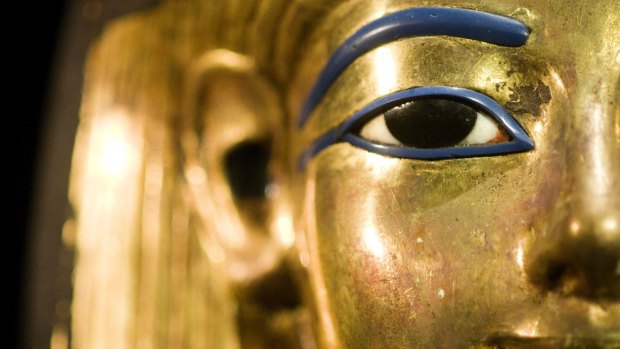This was published 9 years ago
Cairo, Egypt: King Tut's beard glued back on in botched restoration job

King Tutankhamun.Credit: MCT
Some say Tutankhamen's beard was broken off by cleaners; others that it simply came loose. But one thing is now clear: it was hurriedly stuck back on with a splodge of glue.
Conservators at Cairo's Egyptian Museum admitted that the priceless funeral mask of the boy king may have been damaged beyond repair by a botched restoration job.
Recent pictures of the 3,300-year-old relic, discovered by the British archaeologists Howard Carter and George Herbert in 1922, clearly show a layer of ugly resin at the join of the "model beard" - a common feature of Ancient Egyptian gods and kings - and the chin.
Three conservators yesterday gave differing accounts of how the museum's prize exhibit came to be damaged last summer.
They agreed, however, that orders came from above to fix it quickly and that an inappropriate adhesive was used. All spoke on condition of anonymity for fear of professional reprisals.
"The mask should have been taken to the conservation lab but they were in a rush to get it displayed quickly again and used this quick-drying, irreversible material," one curator said. "Now you can see a layer of transparent yellow."
Another museum conservator, who was present at the time of the repair, said that epoxy resin had dried on the face of the golden mask and that a colleague used a spatula to remove it, leaving scratches.
Jackie Rodriguez, a tourist who witnessed the repair work on the beard in late August, provided a photo to the Associated Press showing a museum employee holding it in place as the glue set. "The whole job did look slapstick," she said. "It was disconcerting given the procedure occurred in front of a large crowd and seemingly without the proper tools."
Inside the Tutankhamen exhibition yesterday, the mask remained on display. The museum is one of Cairo's main tourist sites, but in some areas, ancient wooden sarcophagi are unprotected from the public, while linen burial shrouds, mounted on walls, crumble from behind panels of glass.
The vast majority of its rooms lack climate control and the roof has leaked in recent years. Egypt's tourist industry, once a pillar of the economy, has yet to recover from four years of tumult following the 2011 uprising that toppled Hosni Mubarak.
The authorities have made no significant improvements to the Egyptian Museum since its construction in 1902, and plans to move the Tutankhamen exhibit to a new home in the Grand Egyptian Museum, scheduled to open in 2018, have yet to be divulged.
Mahmoud Halwagy, the director of the Egyptian Museum, said there had been no damage since he took over last October. "The mask is in a good condition of preservation but there is an obvious part of adhesive material very visible," he admitted
"This could have happened before," he said, adding that a committee of experts was investigating the incident and would release a report to the public at an unspecified date.
The Telegraph, London
Sign up for the Traveller Deals newsletter
Get exclusive travel deals delivered straight to your inbox. Sign up now.